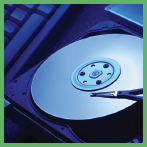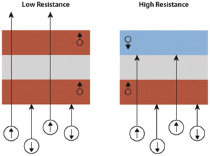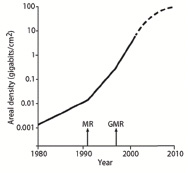
As dusk fell one spring evening in 1820, Hans Christian Oersted bustled round his laboratory preparing for a lecture. Oersted, a professor of natural philosophy at the University of Copenhagen, planned to teach his students about the heating of a wire by an electric current and to demonstrate magnetism using a compass needle.
But as he gathered materials for the demonstrations, Oersted noticed something surprising: When electricity flowed through the wire, the compass needle moved. When he reversed the polarity of the battery providing the current, the compass needle pointed in the opposite direction.
Oersted’s seemingly simple discovery—that electricity creates a magnetic field that will deflect a compass—launched the study of electromagnetics and sowed the seeds for a scientific revolution. Over the next century, great advances were made in the understanding of how magnetism and electrical currents interact, from Faraday’s discovery that a varying magnetic field induces a potential difference, to Lord Kelvin’s finding that a magnetic field can change the electrical resistance of a material. This scientific understanding provided the foundation for the development of the electric motors, generators, transformers, and electromagnets that revolutionized the way we live and work.

Today, scientists are still unraveling the mysteries of electricity and magnetism, but now their focus has zoomed in to the microscopic level, to investigate the interaction between the tiny electrical currents and the quantum-mechanical magnetism (spin) possessed by individual electrons. Technology that harnesses spin and uses it to control the movement of charge is called spintronics.
One spintronics device already in use is the hard disk drive, which stores digital information and delivers it to the rest of the computer system when needed. Since 1997, hard drives have used a spin-based phenomenon to cram gigabytes of songs, documents, photos, and movies into ever smaller spaces.
The information in hard disk drives is stored in small magnetic bits, like tiny compass needles that can be switched between pointing north and pointing south. To read the information from an individual magnetic bit, one must have a sensor, or read head, that is capable of detecting the minute magnetic field emanating from that bit. As hard drives get smaller, the data must be packed more densely, making a mass of magnetic bits (almost one trillion per square inch) that is difficult to decipher.

GMR consists of two extremely thin layers of magnetized material separated by a layer of non-magnetized material in the middle. Each electron can exist in one of two spin states: up or down. Within the atoms of the magnetic material, all the electrons’ spins become oriented the same way, parallel to the magnetic orientation of that particular layer. That affects how electrical current passes through the system: If the two magnetized layers are polarized in the same direction, then electrons spinning in that direction will pass through both layers with little resistance, whereas electrons spinning in the other direction will not. If, however, the layers are magnetized in opposite directions, then all the electrons will face high resistance, regardless of the direction of their spin.
This is where electron spin enters the picture. In 1988, scientists Albert Fert and Peter Grünberg each independently discovered the phenomenon of giant magnetoresistance (GMR), a technology that uses the properties of spin to convert small fluctuations in magnetic field into large changes in resistance (for more explanation, see box). Other scientists quickly saw the potential of the technology for creating read heads sensitive enough to read data stored on miniaturized hard drives: The tiny magnetic fields from each data-storing bit would slightly reorient the magnetizations in a GMR-based read head, creating a significant change in the electrical resistance that could convert the data into an electrical readout signal.
The problem was that the techniques used to make the GMR structure were time-consuming and required very low temperatures and high magnetic fields, making mass production difficult. A breakthrough came when scientists at IBM tried a fast, inexpensive technique called sputtering to create the thin layers of material needed for a GMR system—and it worked. This work paved the way to manufacturing readout heads based on GMR technology that could operate at room temperature.
The era of GMR-based hard disk drives lasted only about a decade, but the spintronics revolution continues. Today’s hard disk drives are based on a newer spintronic technology called the magnetic tunnel junction. Similar in appearance to GMR, magnetic tunnel junctions consist of two magnetic layers separated by a layer of insulator. Most electrical current cannot pass through the insulating layer, but a quantum mechanical property called tunneling magnetoresistance
allows electrons of one spin direction to “tunnel” through. That means the current that flows through is almost entirely either spin-up or spin-down, depending on the magnetic polarization of the surrounding layers. This produces even greater sensitivity to small magnetic fields than GMR and therefore these magnetic tunnel junctions can be used to build even more sensitive read heads.
Spintronic read heads have allowed vast increases in the capacity of digital data storage over the past 15 years (see box) and vast decreases in its cost—for example, it now costs less than one cent to store fifty songs. However, the impact of spintronics reaches well beyond the personal computer. The ability to store and access huge amounts of data has helped to usher in the information age: Most of the information accessible through the Internet is stored on banks of hard disk drives.
The future of spintronics offers other equally exciting opportunities. Currently, a global race is taking place to commercialize a spintronics technology that if successfully developed could remove one of the biggest aggravations of computers—the time it takes a computer to “boot up.”
Most computers use two types of data storage: a hard disk drive, which provides long-term data storage, and a solid state random access memory (RAM) that runs operations. Both types of memory have advantages and disadvantages. Thanks to spintronics, modern hard disk drives can store large amounts of data very cheaply. However, the basic mechanism of hard disk drives has remained unchanged since the 1950s, and is now considered unreliable and slow. Solid state memories read and write data quickly, but information manipulated within the memory of their chips is volatile—that means the information is lost when the computer is powered off or crashes. It must be reread from the disk drive and restored in memory each time the computer is turned on, giving that irritating delay.
To get around this problem, many computers, smartphones, and tablets now use flash, a nonvolatile solid state memory that uses high-voltage pulses of charge to write memory cells. However, flash memory uses a lot of power, and the cell is damaged each time data is written, becoming unusable after about 10,000 writing operations.
A spintronic alternative called magnetic RAM, or MRAM, offers a nonvolatile, power-efficient form of memory. The technology is based on the magnetic tunnel junction: Data are stored in the magnetic state of the magnetic tunnel junction and can be read by the tunneling magnetoresistance of the same device. Because information is stored using magnetic field not charge, processing chips using MRAM technology are nonvolatile and retain data even when powered off. Not only are start-up delays a thing of the past, but power consumption is significantly reduced compared to current chip memories, which need to use power continuously

With the introduction of readout heads based on the spintronic properties of magnetoresistance and giant magnetoresistance, the density of data storage on hard drives has increased. SOURCE: The Royal Swedish Academy of Sciences.
The race is on to learn more about these spintronics phenomena and bring them to the marketplace.
to retain stored information, or flash, which requires high-voltage pulses of energy to write information. Unlike flash memory, MRAM chips do not wear out over time.
The first MRAM solid state drives went on sale in 2006, but work continues to develop higher-density MRAM based on a spintronic effect called spin transfer torque, in which the orientation in a magnetic layer is modified using spin-polarized current instead of magnetic fields. First predicted in 1996 by researchers at IBM and Carnegie Mellon University, spin transfer torque has the great virtue of allowing computer chip magnetic memory bits to be scaled down to very small sizes, just a few tens of nanometers across. In this way it can make possible MRAM products with a very high density of memory bits that are fast, nonvolatile, cheap, and never wear out—all of the attributes that one would want in a memory technology. In the United States today, both large corporations (e.g., IBM, Micron Technology, Intel, Qualcomm) and smaller companies (Everspin, Crocus, Avalanche, Spin Transfer Technologies) have devoted significant effort to commercializing this technology.
With portable wireless electronics becoming increasingly popular, there is a growing need for devices that are power efficient. Consequently, much current spintronics research explores new materials or device designs that provide better energy performance, as compared to charge-based devices (see the Rechargeable Batteries section for another example). Lower-power electronics are also important for database server facilities that will require ever more power as big data applications proliferate. Finally, spintronics concepts are expected to continue to exert strong influence on computer memory.
Classes of spintronics materials other than traditional metal ferromagnets—strongly correlated transition metal oxides are one such class—may help scientists learn more about spin and reveal entirely new phenomena. For example, the recently discovered topological insulators are materials that behave like insulators in their interior but have conducting states on their surfaces—a finding that may further revolutionize spin electronics. The race is on to learn more about these spintronics phenomena and bring them to the marketplace. Research in spintronics has exploded in China, Japan, Korea, and Europe, as well as in the United States.




